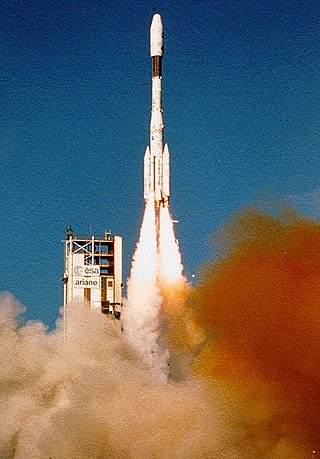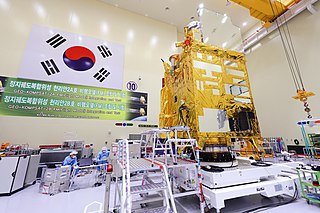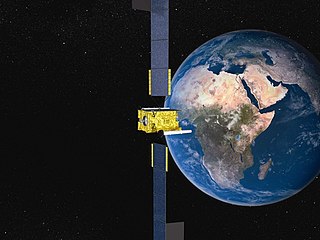
Ariane 5 is a retired European heavy-lift space launch vehicle developed and operated by Arianespace for the European Space Agency (ESA). It was launched from the Centre Spatial Guyanais (CSG) in French Guiana. It was used to deliver payloads into geostationary transfer orbit (GTO), low Earth orbit (LEO) or further into space. The launch vehicle had a streak of 82 consecutive successful launches between 9 April 2003 and 12 December 2017. Since 2014, Ariane 6, a direct successor system, is in development.

Ariane is a series of European civilian expendable launch vehicles for space launch use. The name comes from the French spelling of the mythological character Ariadne. France first proposed the Ariane project and it was officially agreed upon at the end of 1973 after discussions between France, Germany and the UK. The project was Western Europe's second attempt at developing its own launcher following the unsuccessful Europa project. The Ariane project was code-named L3S.

Skynet is a family of military communications satellites, now operated by Babcock International on behalf of the United Kingdom's Ministry of Defence (MoD). They provide strategic and tactical communication services to the branches of the British Armed Forces, the British intelligence agencies, some UK government departments and agencies, and to allied governments. Since 2015 when Skynet coverage was extended eastward, and in conjunction with an Anik G1 satellite module over America, Skynet offers near global coverage.

A military satellite is an artificial satellite used for a military purpose. The most common missions are intelligence gathering, navigation and military communications.

The Arab Satellite Communications Organization is a communications satellite operator in the Arab World, headquartered in the city of Riyadh, Saudi Arabia. Arabsat was created to deliver satellite-based, public and private telecommunications services to the Arab States, in accordance with International Standards. With 21 member countries, the organization plays a vital role of enhancing communications in the Arab World.
Badr-4 is an EADS Astrium-built communications satellite operated by Arabsat, launched 8 November 2006 on a Proton-M/Briz-M rocket. It provides fixed satellite communications services in C- and Ku-bands from the 26° East orbital position.
Astrium was an aerospace manufacturer subsidiary of the European Aeronautic Defence and Space Company (EADS) that provided civil and military space systems and services from 2006 to 2013. In 2012, Astrium had a turnover of €5.8 billion and 18,000 employees in France, Germany, the United Kingdom, Spain and the Netherlands. Astrium was a member of Institute of Space, its Applications and Technologies.
HYLAS is a British satellite in geostationary orbit. HYLAS, which is an acronym for Highly Adaptable Satellite, is a communications satellite and was launched by the European Ariane 5 launch vehicle from the Guyana Space Centre at Kourou in French Guiana. It is located at the orbital location of 33.5 degrees west and will provide new and innovative services including High Definition Television (HDTV) and interactive satellite delivered broadband services. The satellite will help address the issue of poor broadband coverage in many parts of Europe which have less developed ground infrastructure.

Skynet 5B is a military communications satellite operated by Astrium Services, formerly Paradigm Secure Communications, on behalf of the British Ministry of Defence. It was the second of four Skynet 5 satellites to be launched.

Alphabus is a family of heavy geostationary communications satellites developed by a joint venture between Thales Alenia Space and EADS Astrium Satellites in France, with support of the Centre national d'études spatiales (CNES), the French space agency and the European Space Agency (ESA).

Skynet 5C is the third of four Skynet 5 military communications satellites to be used by the British Ministry of Defence (MOD).
Afghansat 1, formerly named Eutelsat W2M, Eutelsat 48B, Eutelsat 28B is a telecommunications satellite operated by Afghanistan's Ministry of Communications and Information Technology.
Eutelsat 4A, previously Eurobird 4A and Eutelsat W1 is a French communications satellite which is operated by Eutelsat. It was constructed by Astrium is based on the Eurostar-2000+ satellite bus. Its launch was contracted by Arianespace, using an Ariane 4 44P-3 carrier rocket. The launch occurred on 6 September 2000, at 22:33 UTC from ELA-2 at the Guiana Space Centre.
Eurostar is a satellite bus made by Airbus Defence and Space which has been used for a series of spacecraft providing telecommunications services in geosynchronous orbit (GEO). More than 70 Eurostar satellites have been ordered to date, of which more than 55 have been successfully launched since October 1990 and have proven highly reliable in operational service. In December 2013, the Eurostar satellites accumulated 500 years of successful operations in orbit. The Eurostar spacecraft series is designed for a variety of telecommunications needs including fixed services and broadcast, mobile services, broadband and secured communications.

Chollian, also known as Communication, Ocean and Meteorological Satellite 1 (COMS-1), was a South Korean satellite which was launched on 26 June 2010 and began operations on 1 April 2011. It was operated by the Korea Aerospace Research Institute, who used it for communication, oceanography, and meteorological observation.
Yahsat 1A is a communications satellite constructed by EADS Astrium and Thales Alenia Space for Al Yah Satellite Communications Company (Yahsat). It was launched in April 2011 from Arianespace's Guiana Space Centre in Kourou French Guiana in a dual payload launch with Intelsat New Dawn atop an Ariane 5 ECA rocket. Yahsat Y1A is based on the Eurostar E3000 satellite bus and had a launch mass of about 6000 kg. It is intended to provide Ku, Ka and C-band communications to the Middle East, Africa, Europe and Southwest Asia. It is in geosynchronous orbit at 52.5 degrees East.

Skynet 5D is a military communications satellite operated by Airbus Defence and Space on behalf of the British Ministry of Defence. It was the last of four Skynet 5 satellites to be launched.
Syracuse is a series of French military communications satellite constellations.
Airbus Defence and Space is the division of Airbus SE responsible for the development and manufacturing of the corporation's defence and space products and providing related services. The division was formed in January 2014 during the corporate restructuring of European Aeronautic Defence and Space (EADS) into Airbus SE, and comprises the former Airbus Military, Astrium, and Cassidian divisions. It is said to be the second largest space company in the world.
INSAT-4B was an Indian communications satellite which forms part of the Indian National Satellite System. Launched in 2007, it was placed in geostationary orbit at a longitude of 93.48° East.








